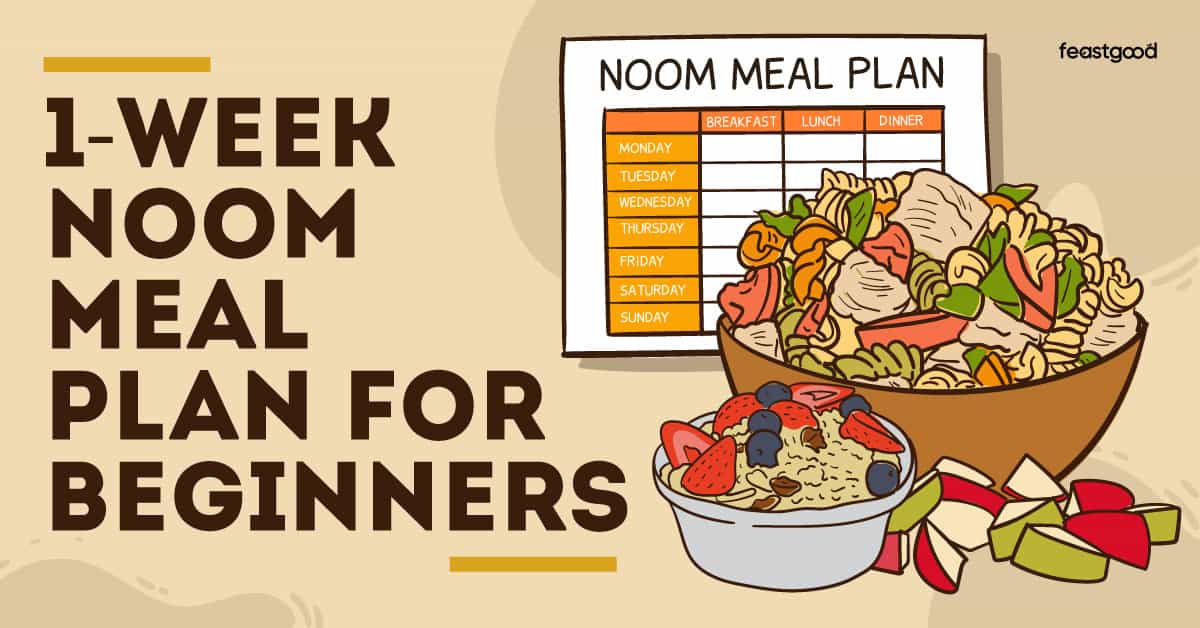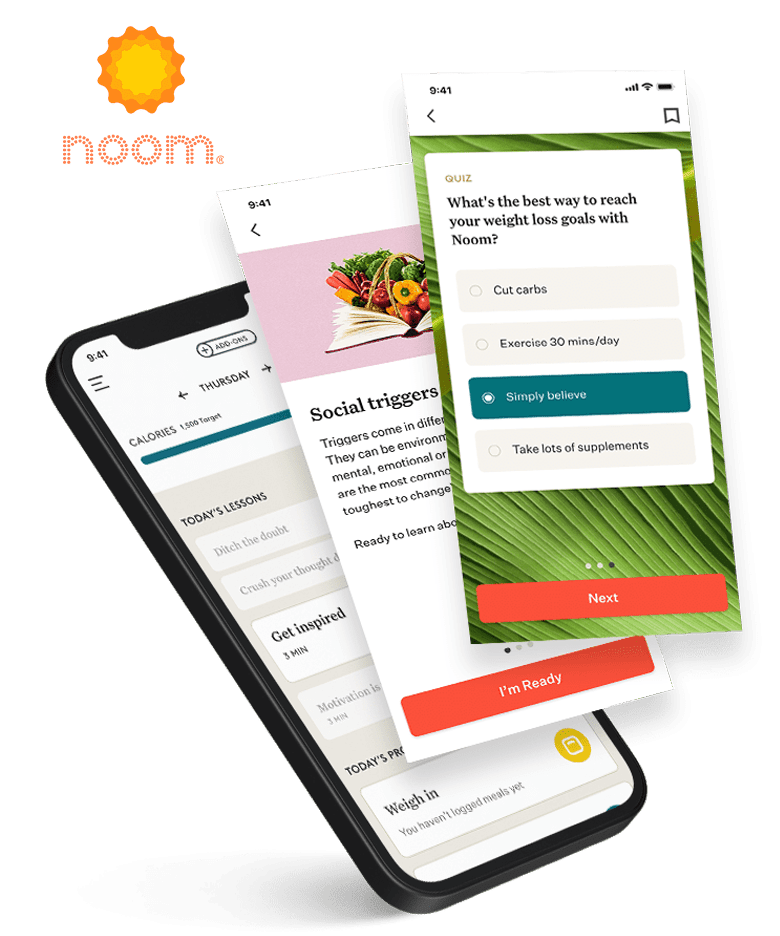As a nutrition coach, I know how hard it can be for clients to figure out what to eat when using a dieting system like Noom, especially when they have a calorie range that they need to stick to in order to see results.
Below, I’ve put together a weekly meal plan to give you some inspiration and guidance when using Noom. I’ve also included a PDF download link if you want to save a copy of the meal plan.
If you haven’t yet downloaded Noom, read my complete Noom Review that discusses everything you need to know before starting.
Main Principles of The Noom Diet
Along with daily psychology lessons, the main principles of the Noom diet are:
There Are No “Good Foods” Or “Bad Foods”
Noom wants to get away from referencing foods as “good” or “bad” because it recognizes that labelling foods in this way can encourage a negative relationship with food.
It also makes it harder for people to be successful with weight loss long-term because avoiding certain foods that you enjoy because you deem them “unhealthy” is unsustainable.
Noom makes it clear that all foods are allowed but some foods should be eaten more often and in larger quantities than others.
Prioritize Nutrient-Dense Foods
The foods that should be eaten in larger quantities and most often are foods that have lots of nutrients because your body requires many different nutrients from food to function optimally.
Nutrient-dense foods are whole foods like fruit, vegetables, whole grains, fish, nuts, and legumes.
Noom encourages you to eat more nutrient-dense foods than low-nutrient foods like pizza, donuts, and cookies so that you’re meeting your body’s nutrient requirements and fueling your body properly.
Limit Calorie-Dense Foods
Noom also encourages users to eat more low-calorie foods that are higher in volume and fill you up than calorie-dense foods that have higher calories even in smaller serving sizes.
For example, 1 cup of watermelon has 46 calories but 46 calories worth of almonds is only 6 almonds. The watermelon would be much more filling than the almonds.
If you’re eating more calorie-dense foods then you’re more likely to overeat and still be hungry, so Noom encourages you to limit these foods and focus on low-calorie high-volume foods instead.
Stay Within Your Calorie Range To Achieve Your Goal In A Timely Manner
Another key principle when using Noom is to stay within the calorie range that has been set for you to keep you on track to meet your goal. The Noom calorie range is very flexible, so you should never feel like it’s too difficult to stay within it.
If you’re within your calorie target then you will achieve your goal more quickly in a healthier way.
Don’t be tempted to go under your calorie range because then you’ll lose weight too quickly and potentially compromise your health and body composition.
Also, if you’re consistently overeating your calorie range then you’re slowing down your rate of progress and it will take you longer to achieve your goal.
Having a calorie range rather than a specific calorie target gives Noom users more flexibility with their intake, which is more realistic.
How To Track Meals on Noom
There are 2 ways to log your meals on Noom based on whether you’re logging your own foods or you’re using a Noom recipe.
To log your own foods, here are the steps:
- Click “Log Your Meals” On The Homepage
- Select a Meal To Log
- Search Or Scan A Barcode To Add Foods
- Select Your Serving Size
- Add More Foods or Click “Done”
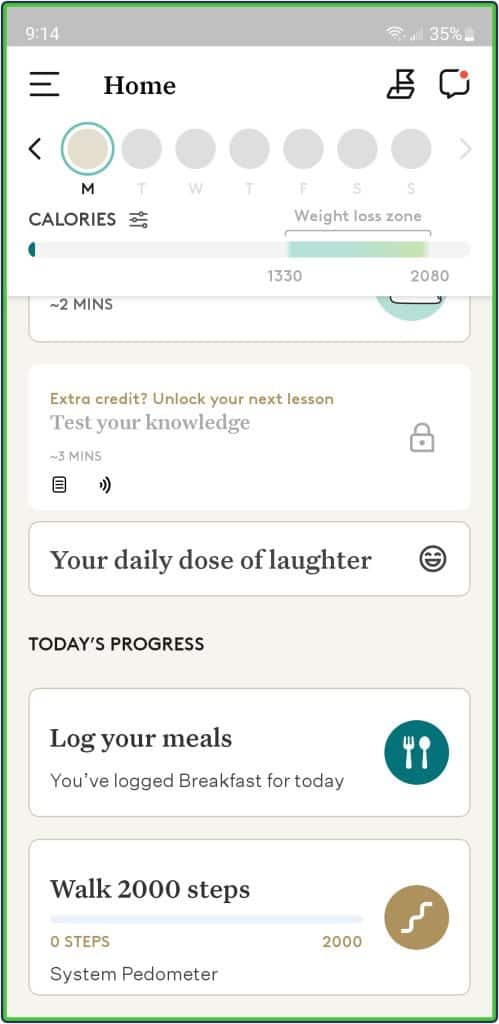
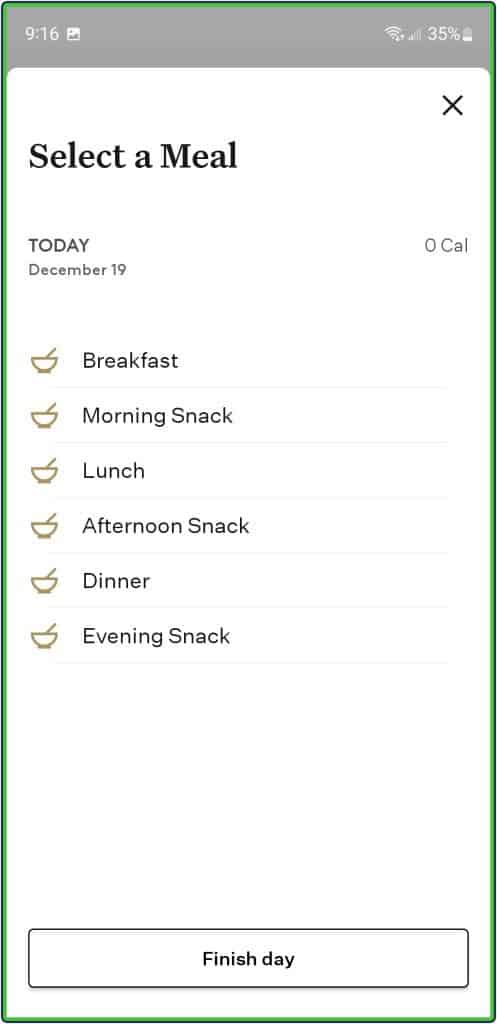
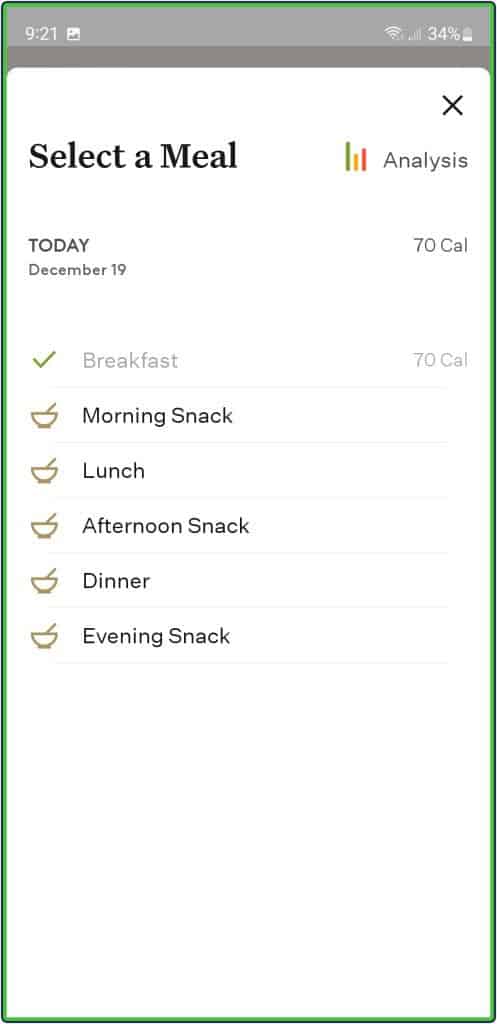
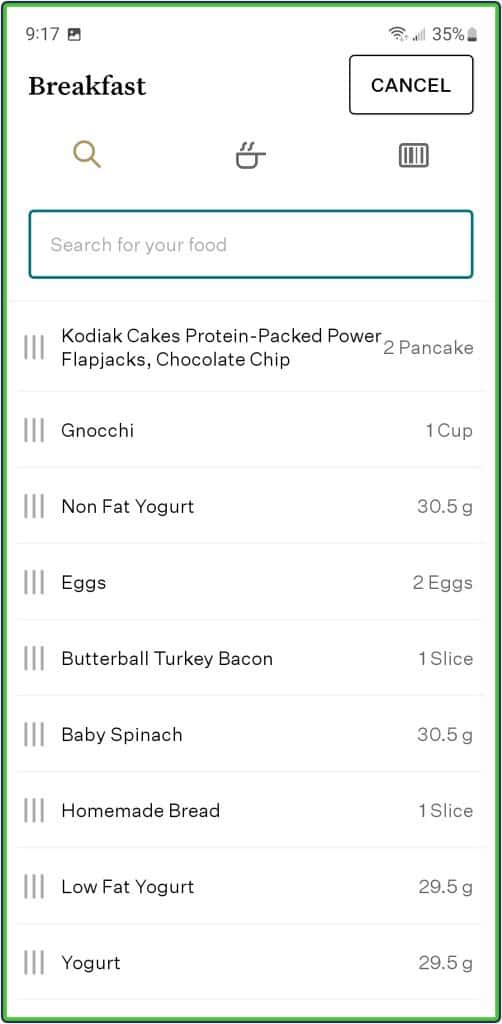
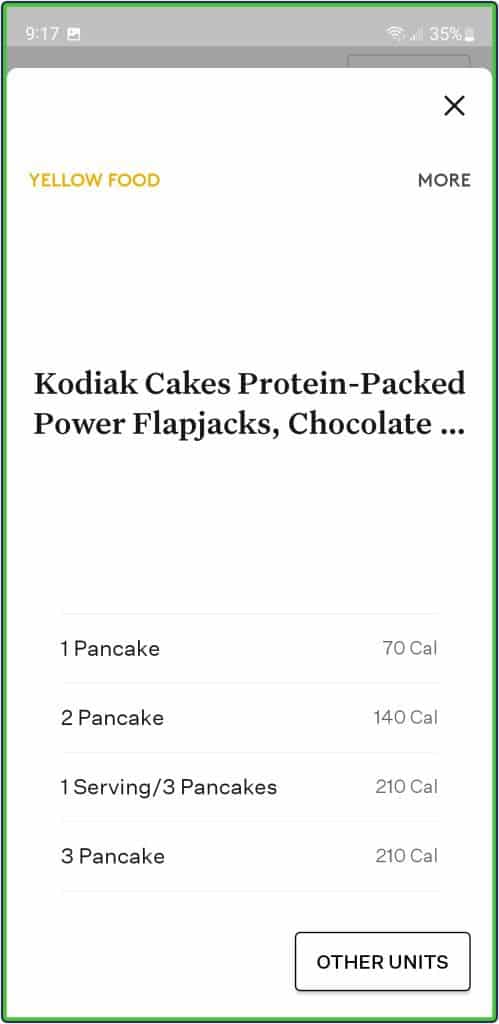
To log a Noom recipe, here are the steps:
- Click “Recipes” In The Drop-Down Menu
- Filter Recipes By Breakfast, Lunch, Dinner, or Snack
- Choose The Recipe You Want
- Click “Log This Recipe”
- Select Which Meal To Log It For
- Select Your Serving Size
- Add More Food or Click “Done”
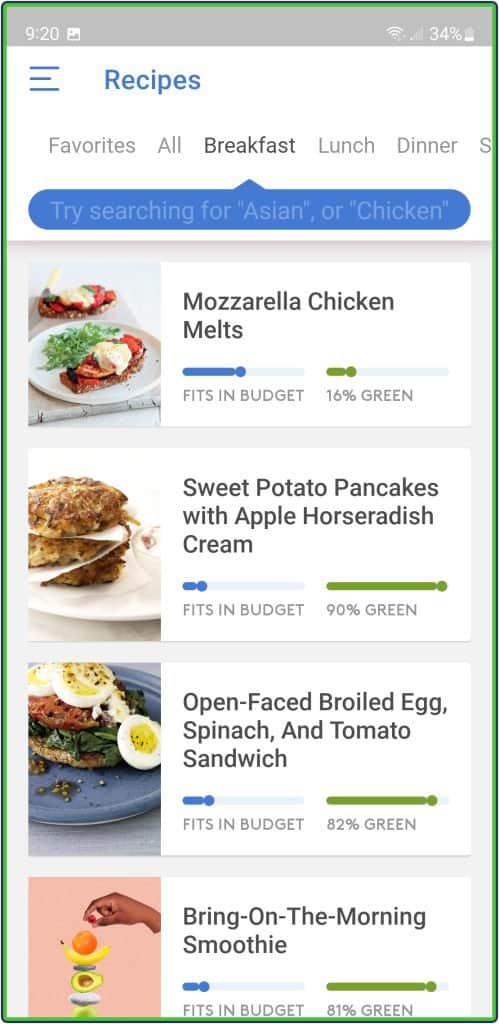
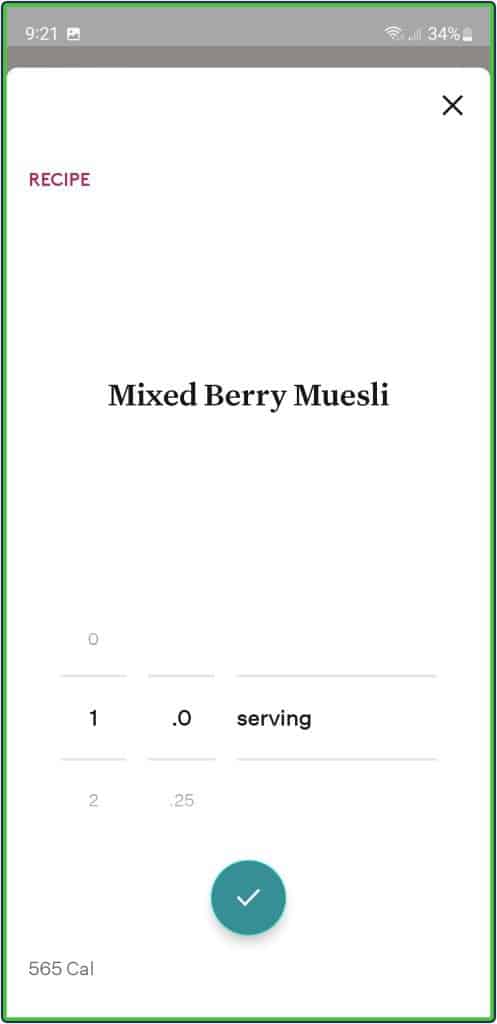
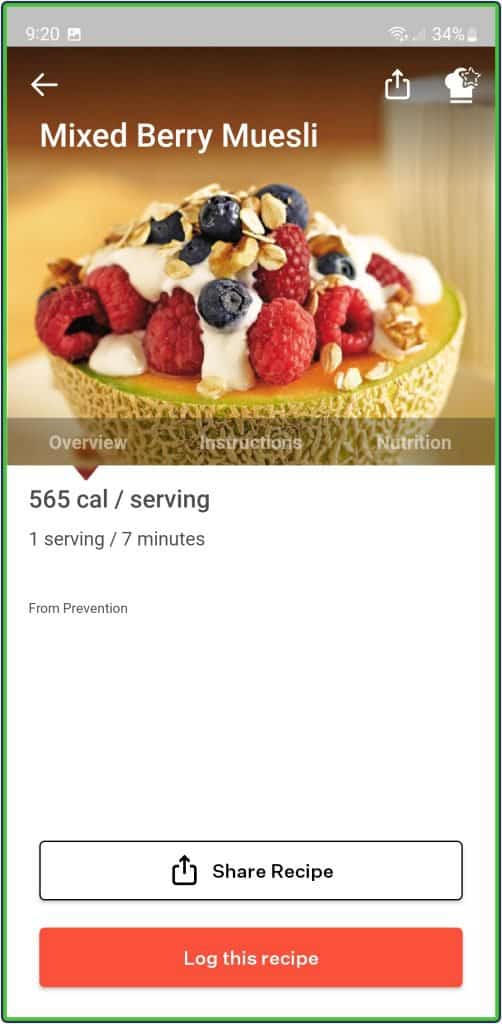
Red, Green, Yellow Foods: What Do They Mean
Noom uses a color code to categorize foods based on their calorie content so that users can make informed decisions about which foods to eat more often.
Red Foods
Red foods (now orange foods as of 2022) are foods that are the most calorie-dense and should be consumed in lower quantities because they add up quickly without filling you up.
It’s important to note that although these foods are higher in calories, it doesn’t necessarily mean that they aren’t nutritious.
For example, pizza is a red food but so are nuts and chia seeds.
- Check out my complete guide to Noom Red Food.
Yellow Foods
Yellow foods are foods that have a moderate calorie content that Noom encourages you to eat in moderation. Yellow foods are foods that have a lower fat content than red foods but a higher fat content than green foods.
Yellow foods consist of most animal and plant-based proteins, low-fat dairy products, and whole wheat grain products.
- Check out my complete guide to Noom Yellow Food.
Green Foods
Green foods are foods that have the lowest calorie content per serving, meaning they fill you up the fastest on fewer calories.
Green foods can be consumed in larger quantities without blowing your calorie budget. However, green foods alone are not enough to sustain you so they should be consumed in combination with yellow and red foods.
Green foods consist of fruits, vegetables, broths, and non-fat dairy products.
- Check out my complete guide to Noom Green Food.
Sample Noom Diet Plan: Here’s What I Ate For 1 Week
Here’s a realistic 1-week walkthrough of what I ate as a nutrition coach while using Noom.
I’ve followed Noom’s principles discussed above but I also make sure I’m listening to my body to decide whether I’m hungry enough for snacks or if my main meals are enough to satisfy me.
Listening to your body by paying attention to your hunger cues is an important skill that you’ll need to lose weight and keep it off.
Feel free to copy the diet plan below, and adjust the portion sizes to fit your caloric target.
Looking for more inspiration? Check out 40 Real Life Noom Before & After Results
Day 1
On Day 1 I was less active and my calorie range was between 1330 and 2080. As I was less active, I wasn’t as hungry for a morning snack, so I skipped it.
- Breakfast: Mixed Berry Muesli (Noom Recipe) – 565 calories
- Lunch: Chicken Pasta Salad (½ cup whole wheat pasta, 1 chicken breast, 1 cup romaine lettuce, ¼ cup cherry tomatoes, ½ cup cucumbers, 1 tbsp feta cheese, and 1 tbsp salad dressing) – 418 calories
- Afternoon Snack: Honeycrisp Apple and 1 tbsp Natural Peanut Butter – 180 calories
- Supper: Beef, Chilli & Orange Stir-Fry (Noom Recipe) – 456 calories
- Evening Snack: 2 cups Air Popped Popcorn – 62 calories
Total: 1681 calories
Day 2
On Day 2, I lifted weights at a medium intensity for 90 minutes so my calorie range increased from 1330-2080 to 1600-2340 calories and so did my appetite.
- Breakfast: Homemade Breakfast Sandwich (2 slices whole wheat toast, 2 eggs, 1 slice low-fat cheese, 1 slice turkey bacon) and an Orange – 434 calories
- Morning Snack: 1 serving of baby carrots, 2 tbsp hummus, and 4 rice crackers – 190 calories
- Lunch: Chicken with Warm Lentils and Kale (Noom Recipe) – 453 calories
- Afternoon Snack: ¾ cup Low-Fat Greek Yogurt + ½ cup Berries – 159 calories
- Supper: Grilled Salmon with Avocado Salsa (Noom Recipe) and ½ cup Basmati Rice – 488 calories
- Evening Snack: Smoothie (1 cup frozen mixed fruit, ¼ cup frozen spinach, 1 cup unsweetened almond milk, 1 serving vanilla protein powder) – 237 calories
Total: 1961 calories
Day 3
On Day 3, I went for a 30-minute run in the afternoon so my calorie range shifted from 1330-2080 to 1490-2240, but I wasn’t hungry after breakfast so I chose not to have my morning snack.
- Breakfast: Oatmeal with Apple, Walnuts, and Banana (Noom Recipe) – 346 calories
- Lunch: Loaded Spinach Salad (Noom Recipe) – 496 calories
- Afternoon Snack: 1 slice Whole Wheat Toast, ½ Banana, and 1 tbsp All-Natural Peanut Butter – 236 calories
- Supper: Chicken Stir-Fry with Gnocchi (1 chicken breast, 1 cup stir fry veg, ½ cup potato gnocchi, and 1 tbsp teriyaki sauce) – 510 calories
- Evening Snack: 10 Grapes, 4 slices Deli Turkey, and 1 oz Low Fat Cheese – 210 calories
Total: 1798 calories
Day 4
On Day 4 I was more sedentary so I didn’t get any exercise activity throughout the day, so my calorie range was 1330-2080. With my activity level being lower, I found that my main meals were enough to hold me over and I didn’t need morning and afternoon snacks.
- Breakfast: Stuffed Cinnamon French Toast (Noom Recipe) – 337 calories
- Lunch: 2 servings Texas Chili (Noom Recipe) – 366 calories
- Supper: Pork Chop with Roasted Sweet Potato and Broccoli (5oz pork chop, 1 sweet potato, 1 cup broccoli, 1 tsp avocado oil) – 475 calories
- Evening Snack: ¾ cup Low-Fat Greek Yogurt, ½ Banana, 1 tbsp All-Natural Peanut Butter, 1 tbsp Chocolate Chips – 329 calories
Total: 1507 calories
Day 5
On Day 5 I had another weight lifting workout that lasted 90 minutes at a medium intensity which changed my intake from 1330-2080 to 1600-2340 calories per day.
- Breakfast: Pancake Breakfast (2 eggs, 1 pancake, 1/2 serving sugar-free maple syrup, 2 pieces turkey bacon, and an orange) – 368 calories
- Morning Snack: Honeycrisp Apple and 1 oz Almonds – 244 calories
- Lunch: Pan Seared Shrimp with Chipotle-Lime Glaze (Noom Recipe), ½ cup Basmati Rice, and ½ cup steamed broccoli – 388 calories
- Afternoon Snack: 10 Grapes, 4 slices Deli Turkey, 1 oz Low Fat Cheese – 210 calories
- Supper: Quick Chicken Curry (Noom Recipe) – 419 calories
- Evening Snack: PB & J Smoothie (1 cup frozen mixed berries, 1 tbsp all-natural peanut butter, 1 cup unsweetened almond milk, 1 serving vanilla protein powder) – 307 calories
Total: 1936 calories
Day 6
On Day 6 I had another medium intensity 90-minute weightlifting workout and I was hungrier than usual so I was in the higher end of my calorie range of 1600-2340 per day.
- Breakfast: Avocado Toast (2 slices whole wheat toast, ½ an avocado, 2 eggs) – 455 calories
- Morning Snack: 10 Grapes, 4 slices Deli Turkey, 1 oz Pistachios – 319 calories
- Lunch: Tuna, Spinach & Tomato Penne (Noom Recipe) – 362 calories
- Afternoon Snack: ¾ cup Low Fat Cottage Cheese, ½ cup Pineapple, ¼ cup Granola – 325 calories
- Supper: 3 oz Pork Chop and Rice-Stuffed Pepper (Noom Recipe) – 587 calories
- Evening Snack: Honeycrisp Apple and 1 tbsp All-Natural Peanut Butter – 180 calories
Total: 2228 calories
Day 7
On Day 7 I went for another 30 minute run which increased my calorie range to 1490-2240. I wasn’t hungry after lunch so I chose not to have an afternoon snack.
- Breakfast: Grilled Banana Sandwiches (Noom Recipe) – 446 calories
- Morning Snack: ½ cup Pineapple and ½ cup Low Fat Cottage Cheese – 131 calories
- Lunch: Thai Chicken Salad (Noom Recipe) + ½ cup Whole Wheat Pasta (to make it a pasta salad) – 430 calories
- Supper: Steak, Potatoes, and Asparagus (4oz grilled steak, 1 small baked potato, and 4 spears of Roasted asparagus) – 559 calories
- Evening Snack: 2 cups of Popcorn, 4 slices Deli Turkey, 10 Grapes – 248 calories
Total: 1814 calories
Download 7-Day Noom Meal Plan
<<CLICK TO DOWNLOAD AND PRINT THIS 7-DAY NOOM MEAL PLAN>>
This meal plan is based on my daily activities and hunger and fullness cues but you can use this as a reference to help you make informed decisions about your Weekly Noom Plan.
To be successful with Noom I believe it’s important to stick to their recommended calorie range and to practice mindful eating to decide whether snacks are necessary that day.
If you’re following this plan and you decide you need a snack on days that I didn’t, that’s completely fine. Simply choose one of the snack ideas from another day of the week to add to your daily intake.
I created my weekly plan by starting with the meals that I wanted and adding snacks as necessary. I suggest you do the same based on your recommended calorie range.
Lastly, to customize this meal plan to your preferences you can exchange any protein for another protein (i.e. poultry for fish), fat for another fat (i.e. nuts for avocado), carb for another carb (i.e. rice for potatoes), fruit for a different fruit, and veg for a different veg.
Check Out These Full Day of Eating Videos Using Noom
For more inspiration on how to eat while using Noom, here are the best YouTube videos:
1. Full Day Of Eating On Noom – Katie Mac
I chose to include this video because Katie walks through the logging process for her meals so you can see how the logging process works if you’ve never used the Noom app. She also included a few tips that I feel are worth mentioning.
Katie’s Pro Tips are:
- Log your food right after you eat so you don’t forget
- Pick 1 to 2 options for breakfasts and lunches for the week to keep things simple and reduce food waste
2. Noom Full Day Of Eating – Colleen Christensen
Colleen is a registered dietitian who logged a regular day of eating into the Noom app to see how her normal eating patterns performed against Noom’s calorie recommendation and color guidelines.
Colleen’s Pro Tip:
- Listen to your body so that you feel good because you can hit your calorie target but still feel awful
Take Home Points
In the first video, Katie was mostly concerned with hitting her calorie target and didn’t really pay attention to the composition of her meals in terms of macronutrients (carbs, fats, proteins), which causes her to be very hungry throughout the day.
If you’re not paying attention to the composition of your meal and only focusing on calories then you’re more likely to be hungry rather than satisfied.
On the other hand, Colleen really listened to her body and ate more balanced meals but didn’t pay attention to her calorie consumption, so she ended up overshooting Noom’s recommended calorie range.
For the best results using Noom, you should find yourself somewhere in the middle of these two approaches. Focus on your calorie target but be sure to pay attention to the food groups (carbs, proteins, fats) that these calories are coming from.
Other Noom Meal Resources
- 35 Noom-Friendly Dessert Ideas (By Nutritionist)
- 35 Noom-Friendly Breakfast Ideas (Approved By Nutritionist)
- How To Use Noom + My Top 6 Tips For Beginners
About The Author
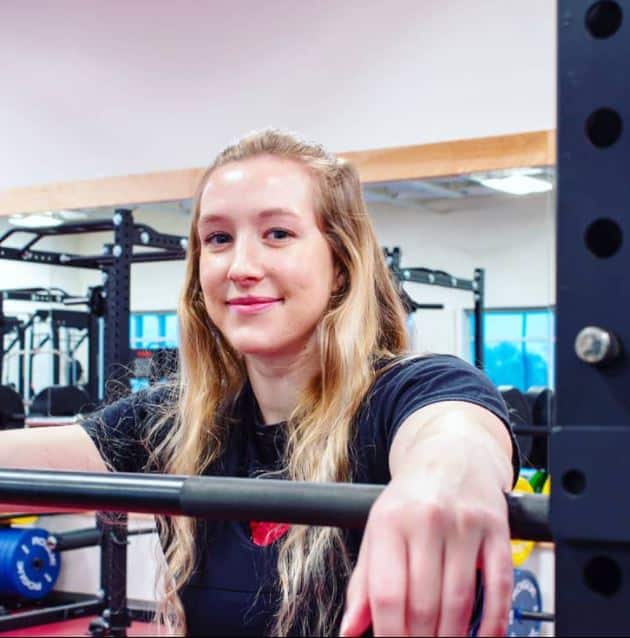
Amanda Parker is an author, nutrition coach, and Certified Naturopath. She works with bodybuilders, Olympic weightlifters, and powerlifters to increase performance through nutrition and lifestyle coaching.
Why Trust Our Content

On Staff at FeastGood.com, we have Registered Dietitians, coaches with PhDs in Human Nutrition, and internationally ranked athletes who contribute to our editorial process. This includes research, writing, editing, fact-checking, and product testing/reviews. At a bare minimum, all authors must be certified nutrition coaches by either the National Academy of Sports Medicine, International Sport Sciences Association, or Precision Nutrition. Learn more about our team here.
Have a Question?
If you have any questions or feedback about what you’ve read, you can reach out to us at [email protected]. We respond to every email within 1 business day.
